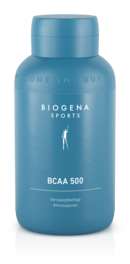BCAAs are becoming increasingly popular in the world of fitness and physical performance enhancement. These essential amino acids are a key component in muscle building and are involved in metabolism, wound healing and tissue formation, among other things. But how do BCAAs work in the body and in which situations is it particularly useful to take these amino acids? Find out how these powerful amino acids can optimally support your training and nutrition plan and what else these little capsules can support you with.
What is BCAA?
BCAAs are branched-chain amino acids. The BCAAs leucine, isoleucine and valine are among the essential amino acids. These three amino acids are referred to as "branched-chain" due to their chemical structure, as they are characterised by a lateral chain (branching). In this context, essential means that the human body cannot produce these amino acids itself and they must therefore be ingested through food.
Leucine
Leucine plays a central role in the energy balance of muscle cells. As a branched-chain amino acid (BCAA), leucine promotes protein biosynthesis in the liver and muscles. This makes it indispensable for building tissue in the human body. It supports the supply of glucose and stimulates insulin production. This makes leucine an important source of energy during training and helps to regulate blood sugar levels. In addition, leucine inhibits the release of cortisol, the stress hormone, and thus protects against muscle breakdown. It also accelerates healing processes in tissue and cells and promotes the growth of muscles and bones.
Occurrence: bound leucine is detected in animal and vegetable proteins such as whey protein, tuna, beef, peanuts and chicken.
Isoleucine
Isoleucine serves as a source of energy during physical activity. When glucose reserves are depleted during exercise, isoleucine is used for gluconeogenesis to form new glucose in the muscle cells. As the body cannot produce isoleucine itself, it is particularly important for athletes to consume sufficient BCAAs before, during or after exercise. Isoleucine stimulates the release of insulin and promotes the uptake of glucose and other amino acids into the muscle cells. It is important for protein synthesis, regeneration and the maintenance of muscle tissue, which is why athletes in the strength and endurance sector in particular rely on it.
Occurrence: sources of bound isoleucine are whey protein, chicken, salmon and beef.
Valine
Glucose can be produced from valine when the body's fat stores and carbohydrate reserves are exhausted. Without sufficient valine, there would be increased protein breakdown in the muscle tissue. Like leucine and isoleucine, valine is also significantly involved in protein synthesis. Together with other amino acids, valine also plays a role in the central nervous system by contributing to the formation of important messenger substances such as glutamate, which are essential for the transmission of stimuli and information between nerve cells.
Occurrence: bound valine is detected in foods such as whey protein, peanuts, fish, chicken and beef.
Why our body needs BCAAs: their effects & functionality
BCAAs…
- support the maintenance and development of muscles
- counteract muscle loss
- regulate energy consumption
- stimulate the release of insulin
- support the formation of tissue in the human body
- regulate blood sugar levels
- support healing processes
- contribute to normal growth
- support the immune system
A crucial aspect of BCAAs is that they cannot be produced by the body itself and must therefore be ingested through food. What is unique about these amino acids is that they are largely metabolised directly in the muscles and not in the liver. This direct metabolisation in the muscles explains their essential role in energy production.
As essential components of human metabolism, BCAAs support important bodily functions and are therefore also used in phases of recovery and strengthening after illness.
Uses of BCAA
The branched-chain amino acids valine, leucine and isoleucine are mainly used to maintain and build muscle in sport, but can also help older people to maintain muscle mass.
BCAAs for building muscle during sport
Protein intake plays a particularly important role in increasing muscle mass, as the amino acids it contains are the building blocks of muscle. As BCAAs are largely utilised directly in the muscles, these amino acids can contribute directly to muscle strength and endurance. They therefore provide an additional source of energy during exercise and stabilise performance during training.
In a sports context, BCAAs are therefore primarily known for accelerating muscle building and counteracting muscle breakdown. During training, glutamine stores in muscles are depleted. In order to prevent a loss of muscle mass, the muscle cells try to produce glutamine from other amino acids during and after exposure to exercise. Leucine, isoleucine and valine are ideal sources for building up glutamine in the muscle.
During intensive physical exertion, the concentration of leucine, isoleucine and valine decreases significantly due to increased consumption both in plasma and in the muscles. This makes them a valuable part of the diet of athletes who want to build or maintain their muscle mass.
Studies show that BCAA supplementation can minimise damage to the muscles and shorten the regeneration time and recovery phase by ensuring that sufficient quantities of free BCAAs are available in the bloodstream at all times to supply the muscle cells. In addition, the immune system, which is weakened by exercise, is also supported.
BCAAs to protect against muscle loss when losing weight, in old age & during rehabilitation
Increased BCAA consumption is also recommended if you want to lose weight. The branched-chain amino acids inhibit muscle breakdown in the body during a diet. This is because when the calorie intake is reduced, the body primarily breaks down muscle mass to generate energy. This has to be averted. BCAA can also help counteract age-related muscle loss and muscle breakdown during the recovery period after operations or injuries.
Supporting the immune system with BCAAs
During exercise, more amino acids are released from muscle tissue to ensure protein biosynthesis in the immune system. A lack of BCAAs inhibits various aspects of the immune system, including the activity of natural killer cells and the proliferation of lymphocytes. However, much is still unclear about the effect of BCAAs on immune function. It is most likely that the most important role of BCAAs for immune cells is related to protein synthesis. In addition, part of the effect can probably be explained by sparing the body's own glutamine reserves. Glutamine is essential for an effective defence system.
BCAA Consumption & Usage
The right time to start taking BCAA:
- With a meal: consume with a meal to maintain and promote muscle protein and improve the amino acid balance.
- Before exercise: to reduce muscle damage caused by muscle strain, take one hour before exercise.
- After exercise: BCAAs should be taken after exercise to promote muscle regeneration.
Where BCAAs are found: BCAA food supplements
BCAAs are an essential nutritional component, especially for athletes. Although these amino acids can generally be obtained through normal food intake, physical exertion often requires a higher amount of BCAAs than is available in the body. For this reason, supplementing with additional products can be useful.
BCAA supplements are available in various forms: powders, capsules, tablets, liquids and ready-to-serve drinks. Each of these forms has its own specific properties and benefits. On training days, it is recommended to take BCAAs in the form of capsules or powder, as they can be absorbed quickly by the muscle cells in this form. Capsules and powders often have the additional advantage that they do not contain sweeteners or flavourings.
An important factor to consider when choosing a BCAA supplement is the ratio of the individual amino acids to each other. The International Society of Sports Nutrition recommends a ratio of 2:1:1 respectively for leucine, isoleucine and valine. This ratio of BCAAs can be traced back to the importance of leucine for protein synthesis in the muscles. There, this amino acid is involved in the activation of a signalling pathway that plays a key role in muscle growth. Leucine therefore has the strongest anabolic effect, which is optimised by the interaction between valine and isoleucine. This ratio is also what is detected in BIOGENA's BCAA preparations. This special composition is designed to meet the needs of athletes and ensure an optimum supply of these essential amino acids.
Daily Requirement & Dosage of BCAAs
As a dietary supplement for athletes who also eat a balanced diet, a BCAA intake of 4-10 grams per day before or after training is generally a good amount to maintain muscle protein levels. Recommended in the literature is 2-5 grams per day to improve the availability of energy in the muscle.
There is an increased need for BCAAs, particularly under stress, during competitive sport, in the case of liver dysfunction, restrictive diets and malnutrition. How much BCAA is actually needed per day also depends on factors such as physical activity, the intensity of exercise, body size and body weight.
BCAA Deficiency & Symptoms
Although a deficiency of branched-chain amino acids is relatively rare, it can occur in athletes, people with vitamin or glutamine deficiencies and those who are malnourished. Such a deficiency can affect the body in various ways and cause different symptoms:
- General well-being: a lack of BCAAs can lead to muscle weakness, which has a negative effect on well-being and physical performance.
- Protein synthesis: impaired protein synthesis can lead to muscle breakdown and poor regeneration after exercise.
- Metabolism: a negative nitrogen balance can occur, which in turn can lead to more protein being broken down than being synthesised. A lack of BCAAs can also impair the detoxification of ammonia in the body.
- Nervous system: a BCAA deficiency can also cause cerebral functional disorders.
As the aim of sport is not only to maintain muscle mass but also to build muscle, a sufficient supply of BCAAs is necessary in excess of minimum recommended levels.
BCAA or EAA: what's the difference?
Both BCAAs (branched-chain amino acids) and EAAs (essential amino acids) are important components in the diet, especially in the context of sport and muscle growth. BCAAs are part of EAAs. Both provide essential amino acids, which act as the basic building blocks of proteins and are indispensable for numerous processes in the body.
Frequently asked questions about BCAAs:
Either is possible – it depends on your goal! Before training – ideally an hour beforehand – they can reduce muscle damage caused by exertion. After training, they help with recovery and muscle building. Our recommendation: 2 x 2 capsules daily with plenty of fluids with meals or 1 hour before intense muscle exertion, 4 capsules to optimally supply your muscles.
Yes, because even during training breaks, BCAAs can help to reduce muscle breakdown on rest days. However, our Protein Sticks are a better choice during such phases – they provide a broader spectrum of amino acids and provide your muscles with even more targeted support.
If you take a longer break from sports, BCAAs can still help maintain muscle mass. Nevertheless, we recommend our Protein Sticks during this time, as they contain other important amino acids in addition to BCAAs – perfect for the regeneration phases.
BCAAs are considered to be generally well tolerated at normal doses and do not usually lead to side effects in healthy people. Studies show that even a long-term daily intake at the recommended levels has no negative impact on health. To be on the safe side, you should stick to the recommended intake or consult an expert or healthcare professional.
BCAAs should either be consumed with a meal or taken about an hour before training, especially if you have an increased need for amino acids as an athlete.
BCAAs serve as an energy source for the muscles, play a decisive role in muscle building, counteract muscle atrophy, support performance, accelerate muscle regeneration and are involved in metabolism, wound healing and tissue formation, to name but a few.
Further reading:
Biesalski, H. K., Grimm, P. Taschenatlas Ernährung, 3. Auflage. Stuttgart: Georg Thieme Verlag KG, 2004.
Hahn, A. et al. Ernährung: Physiologische Grundlagen, Prävention, Therapie, 3. neu bearbeitete und erweiterte Auflage. Stuttgart: Wissenschaftliche Verlagsgesellschaft Stuttgart, 2016.
Gröber, U. Mikronährstoffe. Metabolic Tuning – Prävention – Therapie, 3. Auflage. Stuttgart: Wissenschaftliche Verlagsgesellschaft, 2011.
Henriksson, J. 1991. Effect of exercise on amino acid concentrations in skeletal muscle and plasma. J Exp Biol. 160:149-65.
Greer, B. K. et al. 2007. Branched-chain amino acid supplementation and indicators of muscle damage after endurance exercise. Int J Sport Nutr Exerc Metab. 17(6):595-607.
Negro, M. et al. 2008. Branched-chain amino acid supplementation does not enhance athletic performance but affects muscle recovery and the immune system. J Sports Med Phys Fitness. 48(3):347-51.
Fujita, S., Volpi, E. 2006. Amino acids and muscle loss with aging. J Nutr. 136(1 Suppl):277S-80S.
Aquilani, R. et al. 2005. Branched-chain amino acids enhance the cognitive recovery of patients with severe traumatic brain injury. Arch Phys Med Rehabil. 86(9):1729-35.
Matsuda, T. et al. 2022. Effects of Branched-Chained Amino Acids on Skeletal Muscle, Glycemic Control, and Neuropsychological Performance in Elderly Persons with Type 2 Diabetes Mellitus: An Exploratory Randomized Controlled Trial. Nutrients. 14(19): 3917.
Charlton, M. 2006. Branched-chain amino acid enriched supplements as therapy for liver disease. J Nutr. 136(1 Suppl):295S-8S.
Gröber, U. Orthomolekulare Medizin: Ein Leitfaden für Apotheker und Ärzte, 3. unveränderte Auflage. Stuttgart: WVG Wissenschaftliche Verlagsgesellschaft Stuttgart, 2008.
Breuille, D. et al. 2005. Beneficial effect of amino acid supplementation, especially cysteine, on body nitrogen economy in septic rats. Clin Nutr. 25(4):634-642. doi: 10.1016/j.clnu.2005.11.009.
Shimomura, Y. et al. 2006. Nutraceutical effects of branched-chain amino acids on skeletal muscle. J Nutr. 136(2):529S-32S.
Li, P. et al. 2007. Amino acids and immune function. Br J Nutr. 98(2):237-52. doi: 10.1017/S000711450769936X.
Calder, PC. 2006. Branched-chain amino acids and immunity. J Nutr. 136(1 Suppl):288S-93S.









